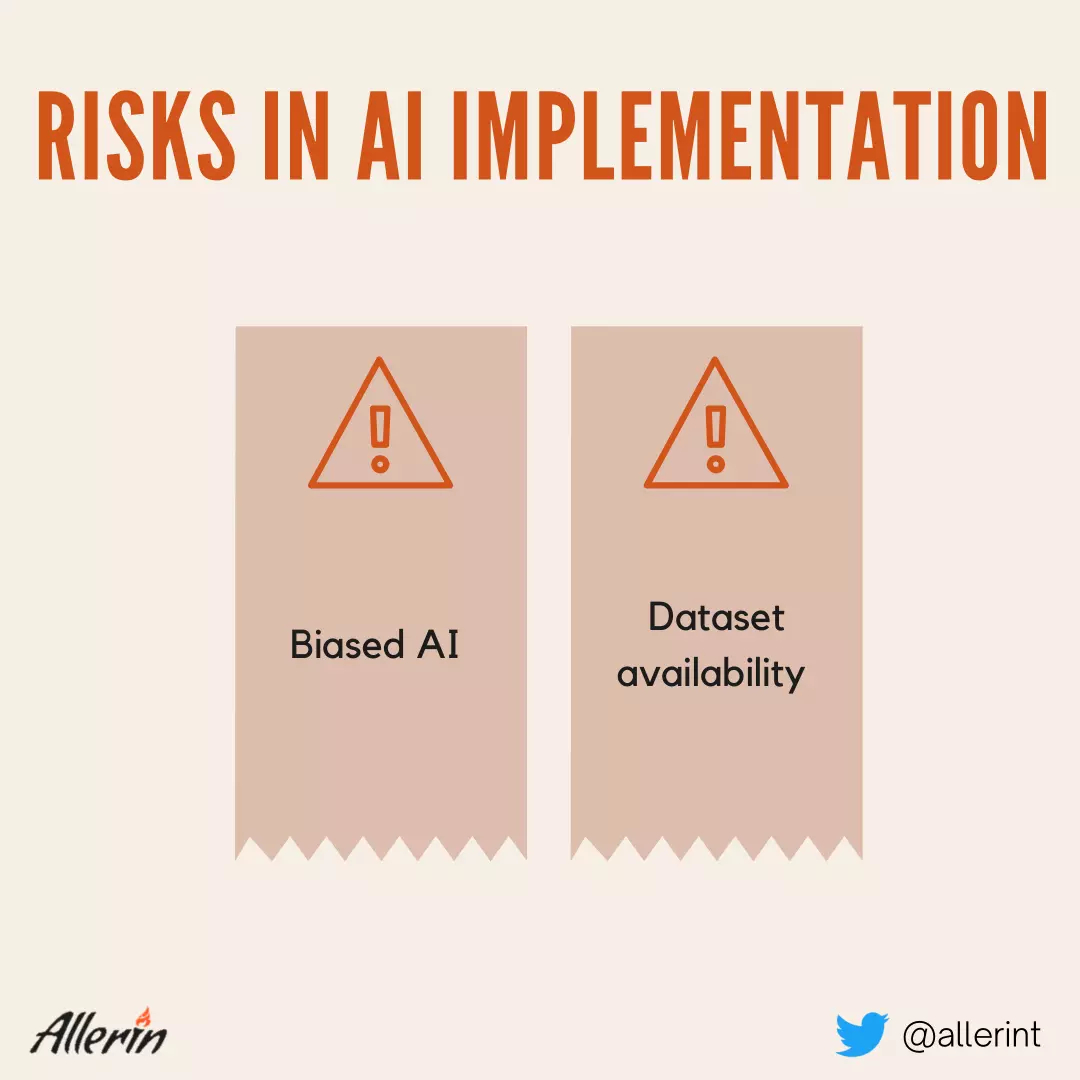Organizations need to gauge and resolve certain inherent risks associated with AI systems and tools before incorporating them into their daily functioning.
Effective management of AI risks by qualified data professionals can allow businesses to exploit the technology’s myriad capabilities to the fullest extent.
Like every evolving concept, AI’s deficiencies are still known only upto a certain extent. Every day, data analysts and IT professionals uncover newer problematic elements in either the technology itself or the way in which it is implemented in various sectors. From what we know about AI already, there are certain clear-cut risks that may present themselves to organizations looking to implement the technology for optimizing their operations. Effective evaluation and countermeasures can allow an organization to find a workaround in risk-ridden situations. The process of risk management begins long before the implementation of AI. Firstly, it is necessary for organizations to prepare their personnel for future AI implementation.
Risks in AI Implementation
Risk assessment and handling can be classified under the broad umbrella of AI risk management. This simplification is done because, generally, organizations seek the shortest route to solutions. As a result, the lines between risk identification, assessment, and resolution get blurred. Here are two of the more common types of risks in AI implementation in organizations:
a) Dataset Availability Risks
As we know, massive datasets are required for training AI models and neural networks in the initial phases of AI implementation. For machine training purposes, organizations will need to source large amounts of data related to consumer trends, financial records, product lines of market competitors, marketing strategies or consumer-related information like frequency of purchase and product reviews. Generating datasets, especially if records and statistics are not maintained and grouped systematically, can be challenging for organizations because records of information may be scattered across several different systems. Additionally, certain data required for model training may be absent. These issues can lead to poor and error-ridden AI implementation while also decreasing the comprehensiveness of datasets. Apart from those, the costs of AI implementation skyrocket as organizations will have to spend more time and money to arrange for datasets for the process.
This problem is fairly basic and organizations would not need to waste a lot of time to resolve it. To overcome the lack of datasets for machine training, organizations can use the concept of using pre-trained AI models and transfer learning. Transfer learning is the process of using pre-trained AI models for training newer models. The process allows IT professionals to reuse the models trained for old processes in order to train new AI networks for operations similar to the old ones. Transfer learning can be resourceful for organizations as the process allows AI models to make forecasts about a supposedly new task by using the learnings from an older dataset with information similar to the new operation.
Before using transfer learning, organizations must take certain precautions. Most importantly, the usage of pre-trained models must only be used if the source and domain data have at least recognizable similarity. For neural networks vastly different from older AI models, transfer learning is not an option. If the older datasets are different from the ones needed for the new model, using transfer learning can produce wildly inconsistent results. Another solution for the lack of datasets is data augmentation. In this process, data analysts increase the number of data points in order to generate a greater number of images or text-form data. Data augmentation is the equivalent of increasing the number of rows and columns in an excel sheet where information is stored. The process is useful to save time and maintain accuracy in data. Although the process may be expensive, it is worth using because organizations would benefit from an intelligent solution for the problem of low training data.
Finally, organizations could use synthetic data to solve the problem of inadequate datasets for machine training. Synthetic Minority Over-sampling technique (SMOTE) and modified-SMOTE can generate synthesized data for machine learning. SMOTE uses minority class data points to create new ones that lie between any two closest data points connected by a straight line. Synthetic data uses concepts such as simulation to generate datasets in this way. Synthetic data can be used to form datasets while keeping organizations on the right side of global copyright laws. The process of SMOTE is especially useful if neural networks have to be taught specific concepts.
b) Biased AI Risks
Bias is a grave concern in AI-powered systems across the world. Certain industries, such as public and privatized healthcare, are more adversely affected by this issue than others. As we know, AI is not human. It does not possess the trivial prejudices that we humans hold towards others of our own species. Therefore, the decision-making and forecasting of AI systems completely depend upon the kind of data that they have been trained with. Despite the presence of several techniques to boost the number of datasets for machine training (some of them are mentioned above), biased AI is fairly common today.
The main cause of bias in AI is the narrowness of datasets. Also, organizations that do not spend the time and effort to find diverse datasets end up with biased AI systems. Bias in AI can be eliminated if organizations use more inclusive datasets for machine training with regards to religion, ethnicity, gender, nationality and race. Organizations need to procure more and more diverse datasets so that the element of bias is eliminated completely from AI decision-making. Organizations can use intelligent algorithms to track discrimination-related problems in AI models and eliminate them.
Streamlining AI Risk Management
As mentioned earlier, the detection, assessment and resolution of AI risks can be blended. The process of Risk management can be broken down into a series of steps enlisted below:
- The first step makes it mandatory for organizations to create policies and principles to deal with AI risks whenever they emerge. The top-level bosses of an organization must be involved in the formation of these as well as to approve the long-term vision for risk management. Using historical data and analytics at their disposal, organizations can form the basis to create crystal-clear guidelines for all the employees in the workplace. As we know, risk management is coordinated Therefore, everybody involved must have a sense of ownership towards the organization.
- After creating a long-term vision and risk management principles, organizations must focus on the conceptualization of a set framework to deal with all kinds of known AI risks. This phase should involve trained and qualified AI experts who can oversee the development of AI models over its life cycle — ideation, data sourcing, model creation, model assessment, industrialization, and performance monitoring. The experts onboard must ensure that risk management measures are implemented at every stage of the life cycle.
- The third step requires organizations to establish AI governance regulations and assign individuals their respective tasks regarding AI risk management. For doing this, the key individuals in data analytics teams must be identified and their roles and responsibilities clarified. Crucially, risk managers must be trained and guided so that they can identify the potential issues in AI implementation in the future.
- One of the key aspects of modern AI risk management systems is flexibility. Data experts from the analytics teams, professionals with risk management duties as well as operational managers and supervisors must communicate with each other on a frequent basis. By doing so, all the internal stakeholders can understand their own responsibilities and can adapt to one another’s work practices. Fluidity in interaction allows organizations to solve conflicts quicker and act in a coordinated way during the development life cycle of AI models. The flexibility of communication channels can allow the IT professionals to focus on AI testing, quality and compliance control.
- The most important virtue of AI in an organization is transparency. Organizations must use the tools that boost AI’s explainability and transparency aspects. Work teams must be trained to use tools to identify the key components of AI models and understand the tasks required to optimally use those components. Designated risk managers and data analytics team leads must enable external service and business partners to have access to such tools for their convenience.
- Your organization must build awareness and institute training so that all the internal stakeholders possess knowledge of new AI model types. Review teams (legal consultants, internal compliance officers) must be approachable at all times so that the compliance and legal risks can be avoided by taking proper measures.
Risk management must be a concerted and cohesive effort for long-term AI strategies to come together in an organization. If implemented correctly, organizations can mitigate the risks associated with AI implementation while maximizing its benefits.




Leave your comments
Post comment as a guest